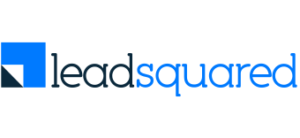Imagine pouring water into a bucket while ignoring the holes at the bottom.
That’s what most businesses unknowingly do with their leads.
You’re investing thousands—or even millions—into marketing campaigns, landing pages, and lead generation. Traffic is flowing in, forms are being filled out, and your sales team is ready to convert.
But today’s funnel isn’t as straightforward as it once was. Buyers don’t move neatly from awareness to conversion anymore—they bounce between channels, do their own research, and engage with multiple touchpoints before ever speaking to sales. Somewhere along this fragmented journey from “interested prospect” to “paying customer,” a huge portion of those leads quietly drop off—lost in the gaps between marketing automation, sales outreach, and customer engagement.
This silent problem is called lead leakage, and it’s costing companies dearly. Research shows that businesses lose up to 79% of their marketing-generated leads to leakage. Picture spending $100,000 on lead generation, only to watch $79,000 worth of opportunities vanish—thanks to broken workflows, disconnected tools, poor follow-ups, or simple human oversight.
What makes lead leakage dangerous is how easy it is to miss. You’ll spot the obvious ones—like a form fill with no follow-up—but most leaks fly under the radar.
They happen quietly:
- A hot lead replies to an email, but it never hits the CRM.
- A qualified contact gets stuck in the wrong nurture flow.
- Two reps reach out, then both back off, thinking the other’s on it.
- A buyer keeps visiting your pricing page, but no one notices.
- A high-intent lead from ads lands on the wrong list.
No alerts. No dashboards. Just silent drop-offs that drain your funnel—and your ROI.
The good news? Lead leakage is preventable. With the right systems, processes, and automation in place, businesses can reach a point of zero lead leakage—capturing, nurturing, and converting every opportunity that comes their way.
This guide breaks down exactly how to do that. You’ll learn where leads typically slip through, how to plug those gaps, and what fixes deliver measurable results. Whether you’re a B2B SaaS provider, an education institution, or a healthcare organization, these strategies will help you stop losing leads—and start converting more of them!
Understanding lead leakage: The hidden conversion killer
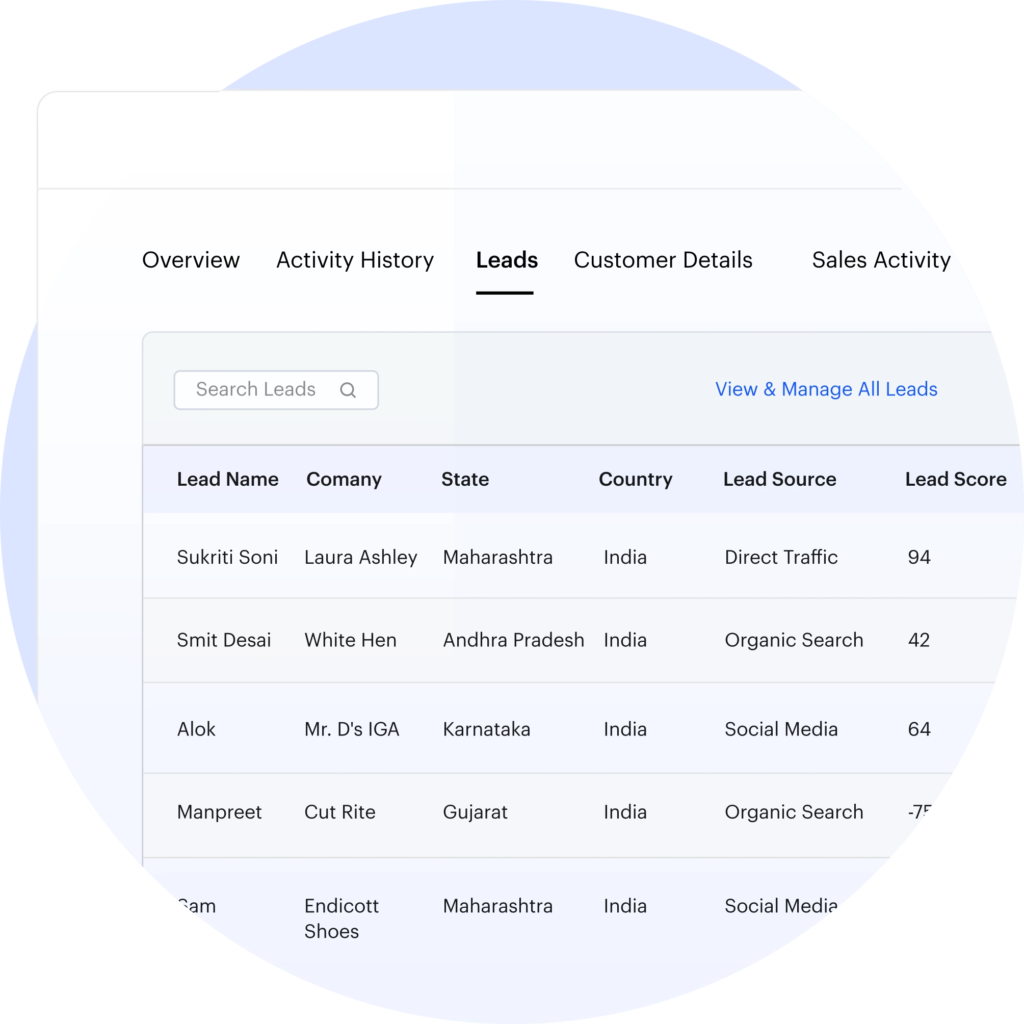
Lead leakage happens when potential customers show interest in your product or service—but never make it all the way through your sales funnel. Remember, we spoke about filling a bucket that has holes in the bottom? No matter how much you pour in, it’ll never fill up until those leaks are fixed.
In marketing and sales, lead leakage takes many forms:
- CRM gaps: Leads collected on your website never sync with your CRM, so your sales team doesn’t even know they exist.
- Form abandonment: Prospects start filling out forms but abandon them due to slow load times or technical errors.
- Lead routing failures: Leads aren’t assigned to the right sales reps or territories, causing delays—or worse, complete neglect.
- Manual data entry errors: A rep mistypes an email or forgets to log a lead—especially common during events, field visits, or high-volume days. Without an automated way to capture leads on the go, valuable contacts simply vanish.
- Untracked touchpoints: Phone calls, chat messages, or social media DMs that never get recorded in your system.
- Integration breakdowns: Disconnected marketing, ad, and CRM systems that don’t share information properly.
Take this real-world example: a healthcare technology company was generating over 500 qualified leads per month through paid ads. But after analyzing their data, they discovered only 280 of those leads were actually entering their CRM. The remaining 220—44% of their marketing investment—were slipping away because of broken form integrations, manual entry mistakes, and delayed imports. That’s nearly $50,000 in wasted ad spend every single month.
You can usually spot lead leakage early if you know what to look for. Warning signs include:
- Declining conversion rates even though traffic is steady or increasing
- Sales teams reporting fewer leads than marketing says they’re generating
- Long delays between when a lead is captured and when the first contact happens
- Mismatched data between campaign reports and CRM numbers
- Rising customer acquisition costs with no clear reason why
Spotting these red flags early is the first step toward stopping lead leakage and protecting your revenue pipeline.
Why lead leakage happens
To fix lead leakage, you first need to understand why it happens. Most businesses don’t lose leads because they don’t care—it’s usually a mix of disconnected systems, unclear ownership, and manual processes that simply can’t keep up.
Inefficient lead capture
Many companies collect leads through multiple disconnected sources—web forms, landing pages, chatbots, WhatsApp messages, phone calls, social media, and event registrations. When these channels aren’t centralized, leads fall through the cracks. A prospect might fill out a form, but if that form isn’t properly integrated with your CRM, that lead vanishes before anyone even knows it exists.
Poor system integration
Today’s marketing and sales tech stacks are complex: ad platforms, automation tools, CRM systems, email platforms, analytics dashboards, and communication apps. When these tools don’t sync properly, data gets trapped in silos. For example, a lead captured from an Instagram ad might sit in your Ads Manager but never make its way into your CRM—meaning your sales team never gets the chance to follow up.
Manual data handling
Relying on people to manually move lead data between systems is a recipe for errors. Sales reps get busy, forget to log calls, mistype email addresses, or postpone data entry until it’s too late. One large real estate firm discovered that nearly 30% of phone inquiries never made it into their CRM because agents were out showing properties and couldn’t log leads right away.
Unclear lead ownership
When it’s not clear who owns a lead, it usually ends up ignored. Without clear assignment rules—by territory, product, or source—reps assume someone else is on it. The result? No one is.
It gets worse when a salesperson leaves or switches roles. Their leads often just sit there, untouched and forgotten. A territory-based lead distribution system fixes this by automatically reassigning leads, so nothing slips through the cracks when teams change.
Lack of automation or timely follow-up
Speed matters. Research shows that between 35–50% of sales go to the vendor that responds first. Yet many companies still depend on manual lead distribution. By the time a lead gets assigned and contacted—sometimes hours or even days later—they’ve already moved on to a faster competitor.
No visibility into the lead journey
If you don’t have visibility into your lead flow, you can’t see where leaks happen. Without proper tracking, you might never realize that 60% of webinar leads don’t reach your CRM, or that chat inquiries convert at half the rate of form submissions. Without these insights, the leakage continues unchecked.
Consider this scenario: A B2B software company spent $200,000 a month on demand generation but couldn’t understand why its sales pipeline kept shrinking. Upon investigation, they found that their webinar tool wasn’t integrated with their CRM; SDRs were manually entering data with a 25% error rate, and territory rules were unclear—so 15% of leads were never assigned to anyone. Those “small” process gaps translated into massive revenue loss.
How lead leakage impacts conversions and revenue
The true cost of lead leakage goes far beyond a few missed sales. When leads disappear, you’re not just losing potential customers—you’re undermining your entire growth potential.
Direct revenue loss
This one is the most obvious. If your average customer lifetime value is $10,000 and 40% of your leads leak out of the funnel, you could be losing millions every year.
Let’s say your business generates 1,000 leads a month with a 20% close rate—that’s 200 new customers. But if 400 leads vanish before they’re even contacted, you’re left with only 600 viable leads and 120 customers. That’s a 40% drop in revenue without spending a single dollar less on marketing.
Poor customer experience
Lead leakage doesn’t just hurt your bottom line—it damages your reputation. When prospects reach out and never hear back, or wait days for a response, they lose trust fast. Even if you eventually follow up, the first impression is already ruined. Those same prospects may tell others about their negative experience or choose competitors who respond faster.
Misleading marketing ROI
Leakage distorts your marketing data. Campaigns that look unprofitable might actually be performing well—you’re just losing the leads before they convert. Conversely, you might double down on channels that appear to perform better simply because fewer leads leak there. Over time, this misalignment drains your marketing budget and weakens your strategy.
Reduced sales productivity
When your team spends hours reconciling missing data, fixing errors, or chasing lost leads, that’s time they’re not selling—time that could have generated hundreds of thousands in revenue.
Here’s an example: An education technology company discovered that they were losing 350 qualified leads every month because of integration failures and manual processes. With an average student lifetime value of $15,000 and a 30% enrollment rate, that leakage translated to $1.575 million in monthly revenue loss—nearly $19 million a year. After automating their lead capture and routing, they reduced leakage to under 5%, recovering over $17 million in potential annual revenue.
Smart fixes to stop lead leakage and boost conversions
Reaching zero lead leakage isn’t about luck—it’s about building smart, reliable systems that eliminate every weak point in your funnel. Here are six proven fixes that deliver measurable results.
Fix #1: Centralize lead capture
The first step is to ensure every single lead—no matter where it comes from—flows into one unified system. That means automatically capturing leads from:
- Website forms and landing pages
- Live chat and chatbots
- WhatsApp and SMS inquiries
- Phone calls (via call tracking)
- Social media messages and comments
- Paid ads (Google, Facebook, LinkedIn, etc.)
- Email campaigns
- Webinars and events
- In-person visits or walk-ins
Use APIs, native integrations, or tools like Zapier and webhooks to push data straight into your CRM (such as LeadSquared) the moment someone shows interest. Eliminate manual entry wherever possible.
Ignore manual entry, use digital forms and OCR to capture customer information quickly.
Fix #2: Automate lead distribution and follow-ups
Speed is everything in sales. Configure your CRM to automatically assign leads based on criteria like:
- Territory or location
- Product or service interest
- Lead source
- Industry or company size
- Lead score or qualification level
Then, use automation to trigger instant actions such as:
- Notifications to the assigned rep
- Automated confirmation or follow-up emails to the lead
- Reminders for reps to reach out
- Escalations if leads go uncontacted beyond a set time frame
Fix #3: Integrate marketing and sales platforms
Tear down your data silos by connecting:
- Marketing automation tools (LeadSquared, HubSpot, Marketo, Salesforce Marketing Cloud Account Engagement — formerly Pardot) with your CRM
- Ad platforms with lead databases
- Email tools with contact management systems
- Analytics platforms with attribution tracking
These integrations ensure that every engagement—from ad click to closed deal—is tracked and visible across teams. Marketing sees which campaigns drive customers; sales sees the full journey each lead has taken.
Set up routine data sync checks and act fast when errors occur. Seamless integration keeps both teams aligned and ensures no lead slips through the cracks.
Fix #4: Real-time lead tracking and alerts
Visibility prevents leaks. Build dashboards that show:
- Total leads captured (by source)
- Leads pending assignment
- Leads awaiting first contact
- Response times and conversion rates
- Bottlenecks and leakage points
Then, configure alerts to trigger when:
- A high-value lead enters the system
- A lead remains uncontacted too long
- Integration or form errors occur
- Lead volume suddenly drops
These real-time insights allow you to spot and fix issues before they turn into lost revenue.
Fix #5: Lead scoring and prioritization
Not all leads are equal—so your best prospects should get the fastest attention. Use lead scoring to rank and prioritize based on:
- Demographics: Company size, role, location, or industry
- Behavior: Pages viewed, content downloads, or email engagement
- Intent signals: Demo requests, pricing inquiries, etc.
- Source quality: For instance, direct traffic often converts better than social ads
Have your CRM automatically flag high-scoring leads for priority handling. You can also use AI-powered lead scoring to predict conversion likelihood and focus your sales efforts where they’ll have the most impact.
Fix #6: Regular data audits and workflow reviews
Even strong systems drift over time. Schedule monthly audits to review:
- Capture rates by source
- Lead assignment performance
- Integration health
- Data quality (duplicates, missing info, incorrect fields)
- Workflow functionality
Hold quarterly process reviews with both marketing and sales to uncover pain points and hidden leakage areas.
Also, maintain good data hygiene—merge duplicates, standardize formats, and enrich incomplete records. Clean, accurate data ensures that no good lead gets ignored or lost in clutter.
How LeadSquared helps you achieve zero lead leakage
LeadSquared is purpose-built to help businesses eliminate lead leakage and maximize every opportunity that comes their way. Its platform addresses every major vulnerability—from lead capture and routing to automation and reporting—so nothing slips through the cracks.
Unified lead capture
LeadSquared automatically captures leads from 100+ connectors, including websites, landing pages, Facebook and Google Ads, phone calls, SMS, WhatsApp, live chat, events, and even walk-ins. Every lead enters a centralized database instantly, complete with accurate source attribution and timestamps—so you always know where your leads came from and when they arrived.
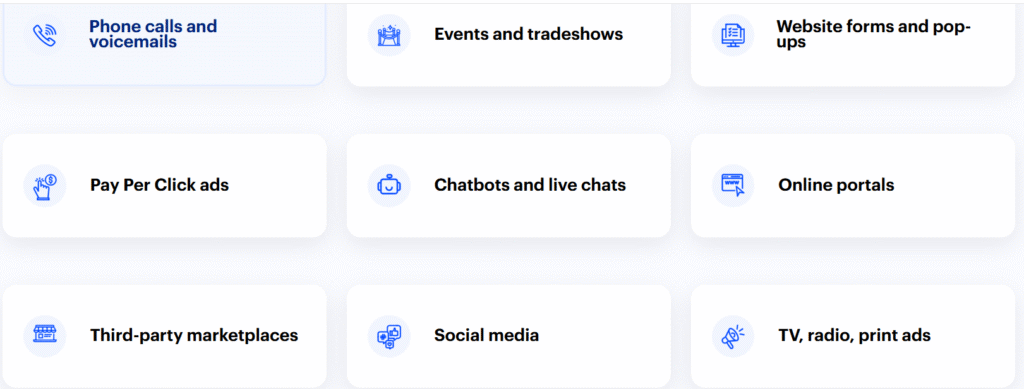
Intelligent lead distribution
With LeadSquared, assignment delays become a thing of the past. You can set up smart routing rules based on geography, product interest, lead score, time of day, or rep availability. Leads are instantly assigned, and reps receive real-time notifications via email, SMS, or mobile push alerts—so follow-ups happen fast and consistently.
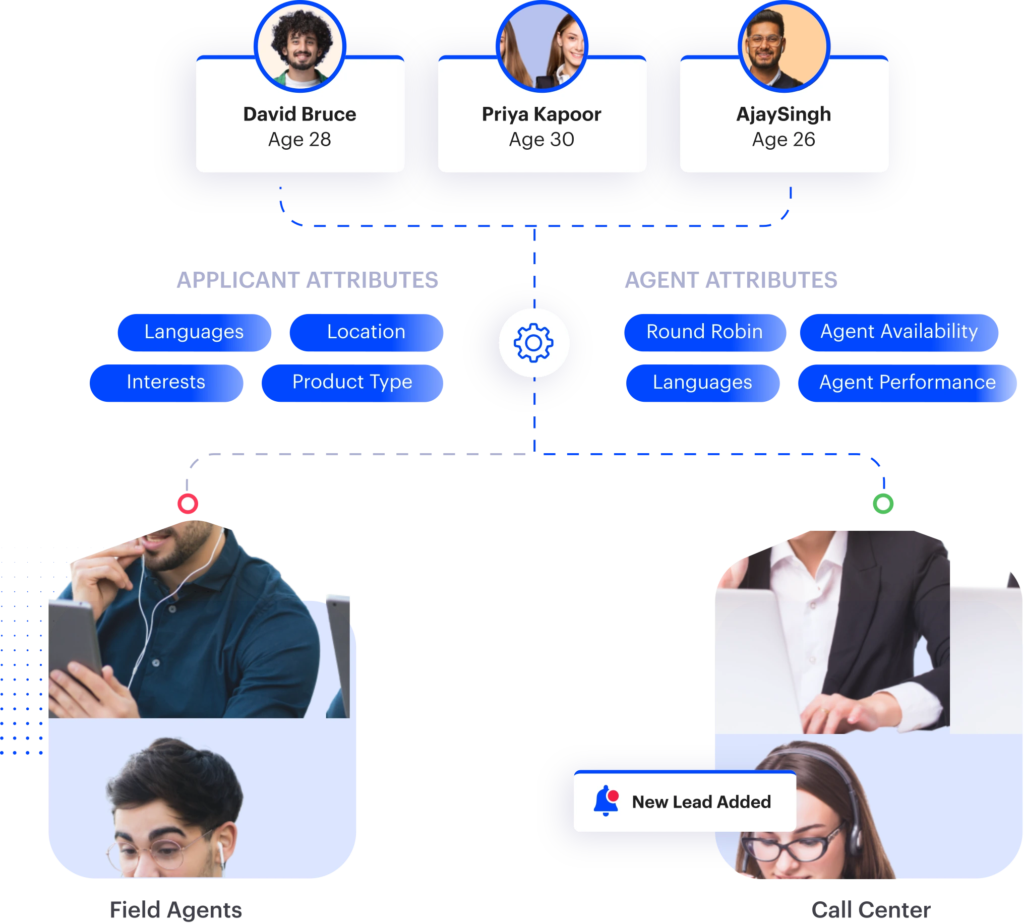
Smart automation workflows
LeadSquared’s automation engine ensures no lead ever goes cold. You can build workflows that automatically send follow-up emails, text messages, or reminders based on behavior, time delays, or custom triggers. If a rep hasn’t contacted a lead within two hours, the system can automatically escalate it to a manager or reassign it to another rep—always keeping the pipeline active.
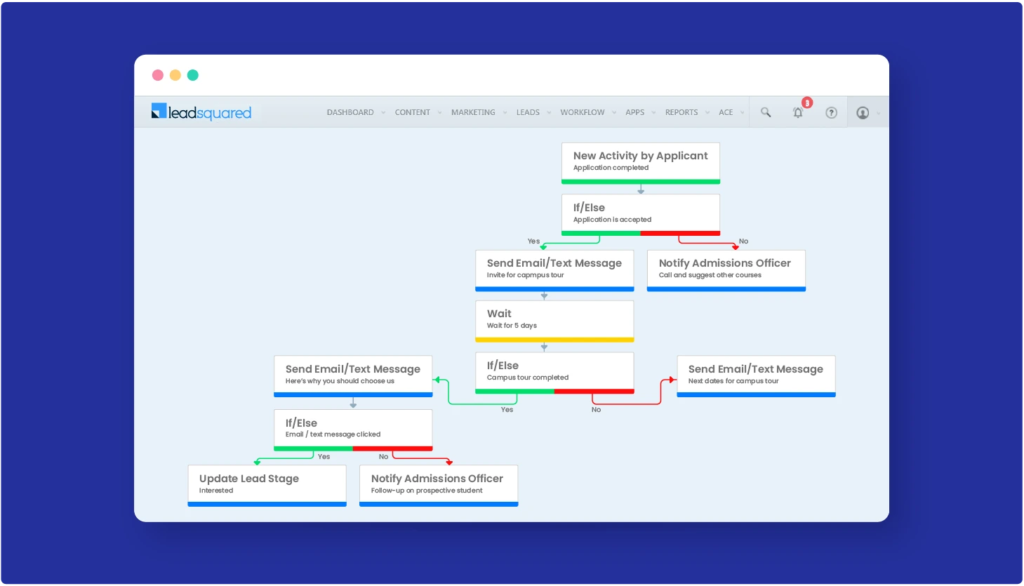
Real-time tracking and visibility
Transparency is key to preventing leaks. LeadSquared offers detailed dashboards that show exactly how many leads were captured, where they came from, who owns them, and how quickly they’re being contacted. If volumes drop, assignments slow down, or conversion rates dip, you’ll see it right away—and fix it before it impacts revenue.

Seamless integrations
LeadSquared integrates effortlessly with your existing tech stack, including marketing automation tools, ad platforms, CRMs, communication systems, and analytics software. Its open APIs make it easy to connect even proprietary systems, ensuring data flows seamlessly across your entire organization.
Sales activity tracking
Every call, email, meeting, and note is automatically logged—giving you a complete picture of every customer interaction. This eliminates forgotten follow-ups, duplicate efforts, and lost context. Everyone on your team can see exactly where each opportunity stands and what’s happened so far.
With LeadSquared’s SIERA (Sales Insights, Efficiency, and Revenue Analytics), you can take this visibility even further. SIERA provides real-time insights into team performance, lead engagement, and conversion trends—so you don’t just track activity, you understand its impact. From identifying bottlenecks to forecasting revenue, SIERA helps sales leaders turn data into action and ensure every lead is moving in the right direction.
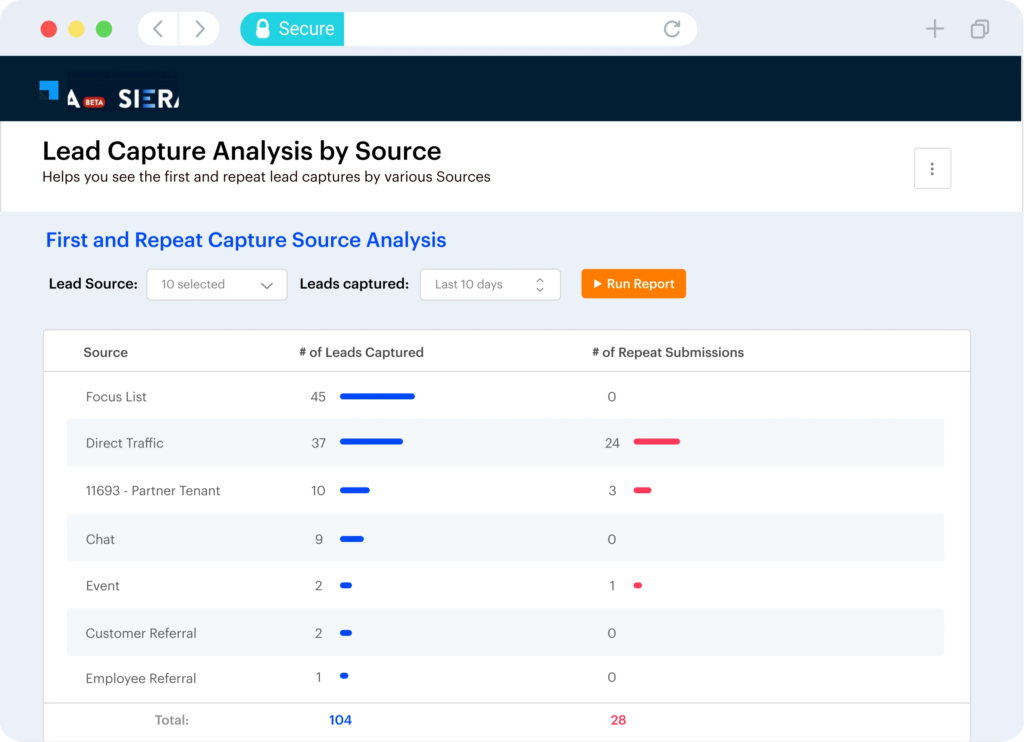
Real-world customer case studies
Explore how LeadSquared helps businesses across various verticals address the lead leakage issue. Check out some real case studies:
Best practices to maintain a leak-free lead funnel
Reaching zero lead leakage isn’t a one-time project—it’s an ongoing discipline. To keep your pipeline healthy and airtight, businesses need to stay proactive, consistent, and data-driven.
1. Maintain continuous data hygiene
Schedule weekly or biweekly checks to merge duplicates, fix incorrect entries, and fill in missing information. Assign someone ownership of data quality, and create validation rules that prevent incomplete or poorly formatted data from entering your CRM in the first place. Clean data equals clean processes—and fewer lost opportunities.
2. Conduct regular system audits
Run monthly technical audits to make sure all integrations, automations, and workflows are working correctly. Test your lead capture forms quarterly across devices and browsers, verify that every source is syncing to your CRM, and confirm that assignment rules are functioning as expected. Even a small disconnect can create significant leakage if left unchecked.
3. Use performance dashboards for leak detection
Build dashboards that clearly display your most important lead metrics—leads captured by source, assignment rates, response times, and stage-wise conversion rates. Set up alerts for unusual drops or deviations from your baseline so your team can take action immediately.
4. Align sales and marketing regularly
Hold biweekly or monthly alignment meetings between marketing and sales. Review lead quality, conversion data, and any process challenges together. These sessions often surface hidden issues that one team alone might not catch—like marketing channels producing unresponsive leads, or delays in sales follow-ups affecting conversions.
5. Invest in training and documentation
Document every process step-by-step, and ensure all new reps are properly trained on lead handling, CRM best practices, and automation workflows. Offer quarterly refreshers and update documentation whenever workflows change. The more consistent your team’s process, the less room there is for leakage.
6. Implement closed-loop reporting
Make sure sales outcomes flow back to marketing so both teams can see which campaigns drive actual customers—not just leads. This full-funnel visibility helps you identify which sources bring in high-quality leads and where to focus future investments.
A great example: one technology company following these practices discovered through routine audits that a webinar integration had quietly failed three weeks earlier. As a result, more than 400 leads never reached their CRM. Because their monitoring system caught the issue quickly, they were able to recover and process those leads before they were lost for good.
Wrapping up
Lead leakage is one of the costliest—but entirely preventable—problems in marketing and sales. Every lost lead represents wasted spend, missed revenue, and an opportunity handed straight to a faster competitor.
The roadmap to zero lead leakage is clear:
- Centralize your lead capture
- Automate distribution and follow-ups
- Integrate your tech stack
- Monitor your funnel in real time
- Prioritize high-intent leads
- Keep your systems clean and aligned
The businesses that win aren’t necessarily those spending the most on marketing—they’re the ones making the most of every opportunity they generate. By putting these strategies in place, you can stop valuable leads from slipping away, boost your conversions, and unlock more revenue from the efforts you’re already investing in.
Don’t let another qualified lead vanish.
Discover how automated lead management with LeadSquared can safeguard your pipeline—and accelerate your business growth.
FAQs
What is lead leakage?
Lead leakage happens when potential leads slip through the cracks and never make it into your sales process — for example, when inquiries from calls, forms, or chats aren’t captured or followed up on. With LeadSquared, you can eliminate lead leakage completely by automating lead capture from every source and ensuring instant routing to the right salesperson.
What does “no lead” mean?
“No lead” usually means there’s no record of a new prospect or inquiry in the system. In other words, no contact has been generated, captured, or assigned for that interaction or time period.
How does lead leakage affect sales conversions?
Lead leakage directly impacts sales conversions by reducing the total number of leads that reach your sales pipeline. When leads go missing due to poor data capture, delayed follow-ups, or untracked touchpoints, your sales team loses potential buyers before they even enter the nurturing cycle. This not only lowers conversion rates but also wastes marketing spend and skews performance metrics. Over time, consistent lead leakage can erode revenue potential and weaken customer trust, making it harder to forecast sales accurately.
What are the main causes of lead leakage in CRM systems?
Lead leakage in CRM systems usually stems from process gaps and technical inefficiencies. Common causes include:
Incomplete lead capture: Leads from forms, chats, or calls not syncing properly into the CRM.
Manual data entry errors: Sales teams forgetting to record or update leads.
Poor system integrations: Disconnected marketing and sales tools causing data silos.
Unclear lead ownership: Leads not assigned to the right sales reps in time.
Lack of automation: No workflows to ensure timely follow-ups or reminders.
Ultimately, when the CRM lacks visibility, automation, and accountability, leads fall through the cracks unnoticed.
How can businesses reduce lead leakage effectively?
To reduce lead leakage, businesses must focus on automation, integration, and accountability. Start by centralizing all lead sources in one CRM to ensure every inquiry—whether from a form, ad, or chat—is automatically captured. Next, implement automated lead distribution and follow-up workflows so that no lead remains unattended. Regular data audits, performance dashboards, and cross-team visibility further help in identifying leak points early. Continuous training and clear ownership ensure every lead is tracked, nurtured, and converted efficiently.
Which tools help in preventing lead leakage?
Tools that automate lead capture, routing, and tracking are essential to prevent lead leakage. A robust CRM platform integrated with your marketing and communication channels ensures every lead is recorded, assigned, and followed up on time.
Digital lead capture tools—like mobile forms, OCR-based card scanners, and dynamic web forms—make sure no lead slips away, whether it’s collected online, at an event, or in the field. Combined with automation platforms, workflow engines, and sales performance dashboards, they help maintain transparency, accountability, and real-time visibility across your entire funnel.
LeadSquared is one of the most effective platforms to achieve zero lead leakage — offering end-to-end automation, multi-channel lead capture, real-time alerts, and seamless CRM integration that help businesses plug leaks and boost conversions.
